Guide to Starting a Successful Trucking Business
The trucking industry plays a vital role in the U.S. economy. Across North America, thousands of companies operate on a local, regional, national and international scale, transporting goods across county, state, country and province lines. Starting a successful trucking company requires an understanding of trucks, routes, transport laws and industry patrons. Not sure if you should start your own trucking company? We created a comprehensive guide just for you! Including:
- Industry Overview
- Step 1: Considerations When Starting a Trucking Business
- Step 2: Developing a Business Plan
- Step 3: Covering Legal Trucking Requirements
- Step 4: Assets & Expenditures
- Step 5: Finding Clients & Hauls
Truck owners with an interest in transport often have a goal of founding a company. Determining whether starting a trucking company is feasible for you requires asking yourself a series of more complex questions.
Questions to Ask Yourself if You’re Wondering: Should I Start a Trucking Company?
- Could you see yourself managing a fleet of trucks?
- Do you have the gumption to secure the startup capital?
- Are you willing to study and familiarize yourself with complex transporting laws, federal regulations and insurance requirements?
- Are you driven to promote your brand and compete for customers?
If the answer to these questions is “yes,” read the following steps on how to start a successful trucking company.
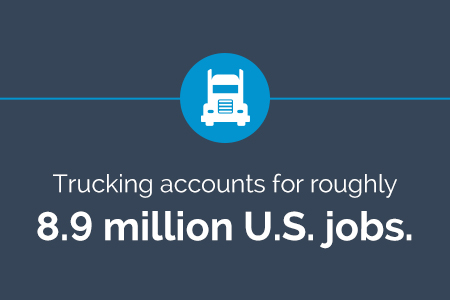
What You Need to Know About The Trucking Industry
The trucking industry is one of the most lucrative industries across the United States. At various levels of the industry, trucking accounts for roughly 9 million U.S. jobs. One of the most notable examples is UPS, which employs more than 60,000 drivers. Another is LTL Shippers, which claims at least one-seventh — 13.6 percent— of the U.S. trucking industry.
Overall Revenue Made By The Trucking Industry
More than two-thirds of freight transportation across the U.S. is reliant on the trucking industry. Many of the companies counted in that figure also cross borders, north and south, to deliver goods to customers in Canada and Mexico. In terms of overall profit, the North American trucking industry generates the following monies:
- $671 billion in domestic business
- $295 billion in U.S./Canadian trade
- $195.6 billion in U.S./Mexican trade
Out of all the products the trucking industry transports, the highest-volume are concrete, clay, glass, stone and farming products, which drive 6 percent of domestic road shipments. Close behind are food, lumber, petroleum and coal, which account for 34.8 percent of U.S. road shipments.
Regulatory Agencies for Trucking Laws
The following federal agencies have regulatory oversight of the U.S. trucking industry:
- United States Department of Transportation (USDOT)
- Federal Motor Carrier Safety Administration (FMCSA)
- Federal Highway Administration (FHA)
The purpose of the regulations enacted by these agencies is to ensure trucking companies adhere to laws and safety standards, and that drivers undergo strict training.
Starting Your Trucking Business
Step 1: Things to Consider
Trucking Business Models
Trucking companies earn business through bids on transporting contracts. The work of transport can be conducted under two different business models: one that uses subcontracted drivers, and one where you employ an in-house fleet.
- Subcontracted drivers allow you to save money during the startup phase of your business because the drivers bring their own trucks and handle their own insurance coverage. On the other hand, the subcontractor option is less profitable and restricts your control of operations.
- An in-house fleet means you own the trucks and employ the drivers. As such, you must purchase insurance for the vehicles and drivers. Even though this option carries more overhead, you exert greater control of your operations and wield more profit potential when you purchase a fleet of trucks and hire your own team of drivers.
For the upstart trucking business, the best practice is to start small and work your way into a large-scale operation as you gain more clients. In the beginning, you can operate with a single truck and gradually build a fleet as business increases and you need to hire more drivers for deliveries.
Market Demand
Trucking is an industry that serves an ongoing need to businesses and the public at large. There is no estimated downfall of the demand for trucks, and trucking companies. In an era that has seen disruptive computer technology act as the death knell to various other trades, trucks ship physical items consumers cannot stream or download. As long as there is human activity, an industry will need to transport food, lumber, oil, glass and numerous other products from one city to another.
By and large, the trucking industry is lucrative because businesses and consumers alike depend on the safe delivery of vital goods at all points on the map. That said, some newer companies fail to cover their bases and research the market properly. As expected, these are the companies that quickly blow their startup capital and fold shortly out of the gate.
Customer Segments
Various industries in the private sector rely on the trucking industry, including merchants, farmers, contractors and manufacturers. The biggest niche services in the trucking industry include:
- Food deliverers
- Courier firms
- Private carriers
- And For-hire carriers
Competition
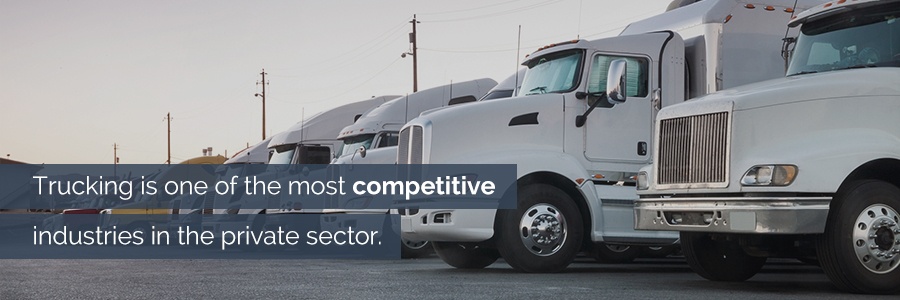
As a lucrative, in-demand industry, trucking is one of the most competitive industries in the private sector. Throughout each state and city, large and medium-sized trucking companies compete for some of the highest-traffic shipping trades on a local, intrastate, regional and national scale.
Despite the competitive nature of the trucking industry, there is always room for upstarts that wish to join in the competition. Many of the industry’s newcomers begin as owner-operators or for-hire carriers.
Intrastate vs. Interstate Trucking
The first thing to consider when you start a trucking business is the purpose of your service and your intended range of coverage. Some trucking businesses stick to local transport and operate strictly intrastate. Other companies cover broader areas on a regional and national scale.
- Intrastate commerce would be if you’re transporting goods within the same state. Intrastate trucking companies’ regulations are simply governed by the Occupational Safety & Health Administration (OSHA).
- Interstate commerce is the more common type of trucking commerce, and occurs when trucks travel across state lines. Intrastate commerce trucking regulations are set by the US DOT, and each state has different regulations regarding the transport of goods from outside state lines.
Risks & Challenges of Trucking Businesses
Aside from competition, some primary challenges trucking companies face include:
- Economic downturn
- Changing markets
- Spikes in fuel costs
For the newer company that hopes to rise into the big league, the most common missteps include:
- Mismanaged revenue structures
- Spiraling debts
- Inability to scale efficiently
By being aware of the challenges you may face with your trucking business, you can better plan, organize, and manage your business.
Step 2: Developing a Business Plan
As with any new business undertaking, you need to develop a plan if you wish to enter the trucking industry. Your business plan will need to cover every practical aspect of starting a company and making it financially viable. Thankfully, various software programs make it easier than ever to develop complex business plans.
Outline Your Plan
The purpose of a trucking business plan is to outline the steps required to initiate your business and make it move and thrive. The basic outline of a business plan should include an executive summary, as well as information on each of the following concerns:
- Company description
- Mission statement
- Business structure
- Employment policy
- Marketing analysis
- Sales strategies
- Pricing
- Financial forecast
- Advertising
- Budget/startup capital
While you might be tempted to set far-reaching financial goals within short measures of time, this could set you up for disappointment. To achieve a stable and upward-moving trajectory, it is best to set realistic goals — or perhaps even underestimate your initial forecast — for the first several months of your company’s existence.
Select a Business Location
In the trucking industry, you have to get your name in the market and find business. Early on, you need to determine how long it takes to deliver goods, as this will form the basis of your rates.
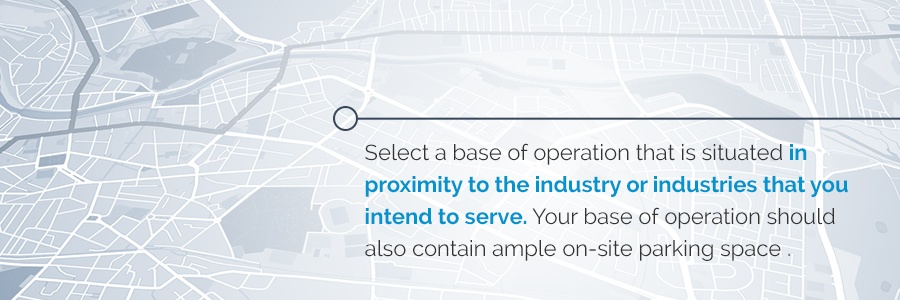
As you plot out your business, select a base of operation that is situated in proximity to the industry or industries that you intend to serve. For example, if you intend to ship textiles, keep your eye on a location near the textile manufacturers in your area.
Your base of operation should also contain ample on-site parking space and be situated near the area’s major highways. Preferably, the layout of your headquarters and the surrounding streets should allow you to drive out from the lot and onto the nearest highway with only a minimum of stops.
Purchase Trucks
One of the first budgeting concerns with the startup of your business will involve the purchase of trucks. You might start with one truck and gradually build a fleet.
If you have sufficient financing or an offer that would allow you to pay for a truck in increments, go for a new truck. If you lack the resources or backing, choose a used truck. The latter might require maintenance, but a decent used truck will serve all the same purposes as a new truck.
Employ Maintenance/Install Trackers
You can contract out the maintenance on your trucks or hire in-house specialists. If you are starting a medium-sized trucking business, contract maintenance should suffice for the time being. However, if you are aiming to launch a large-scale trucking company, you will need to have a capable in-house maintenance crew as early as possible.
To maximize the efficiency of the trucks in your fleet, have trackers installed on each truck. With a tracker, you can monitor the whereabouts of each truck and the time it takes for each driver to reach a given destination. This will allow for more realistic delivery schedules and effective routing plans.
Hire Your Staff
For a trucking business to operate, you will need to have qualified individuals to fill the following key roles:
- Chief operating officer — this would be you, the owner.
- Transport and logistics manager
- Admin/HR manager
- Front desk officer
- Accountant
- Marketers
Finally, you will need to hire drivers to operate the trucks. At a minimum, a trucking business requires a 10-member staff.
Devise a Management Strategy
To draw business, you must have a master marketing plan. Your company’s marketing will need to be attention-getting and persuasive to attract a clientele and build a reputation. The type of products you transport will ultimately define your company in the market.
Don’t limit the task of marketing to personnel in the marketing department. In fact, all company personnel should be involved as active marketers for the company at every opportunity. This would include the drivers, who can promote the company wherever they go by handing out business cards and sharing information about services and rates to potentially interested parties.
Develop a Management Protocol
As with most companies that achieve high levels of success in their chosen industries, the success of your business will largely depend on your management style. With an emphasis on the following four management fundamentals, you can achieve a collective sense of motivation and satisfaction from your workforce:
- Training — Make sure each employee is thoroughly trained in the functions of his or her position.
- Meetings — Hold regular meetings to ensure that everyone is up-to-date on company progress and changes of protocol.
- Maintenance — Inspect all trucks and hauling/lifting devices regularly, and repair them whenever necessary.
- Upgrades — Be on the lookout for technological innovations that could improve your company’s arsenal and make work easier for your employees.
The progress of your business will also rely on the input of your employees, many of whom will offer valuable insights gained through on-the-job experiences.
Step 3: Cover the Legal Requirements
As with any industry that involves delivery vehicles and traffic navigation, trucking is a risky business. When you consider the possibility of roadside accidents, vehicle failures, theft, injuries and fatalities, the operation of a trucking business involves high costs, liabilities and legal ramifications.
Select a Legal Entity to Operate As
As a legal entity, a trucking business can operate under one of the following structures:
- Sole proprietorship
- General partnership
- Limited partnership
- LLC
- “C” corporation
- “S” corporation
Each structure has its own advantages. When you start a trucking business, base your choice of legal structure on your company’s size and scope.
Though it is wise to study the legal factors of each structure, industry experts generally agree the most favorable option for a trucking company is to file as a limited liability company (LLC). As your business grows and you wish to go public, you can do so by converting to a “C” corporation.
If you operate small with just a single truck for your first few months of business, you might find it more practical to file as a sole proprietorship and convert to LLC later, once you add more trucks and employees.
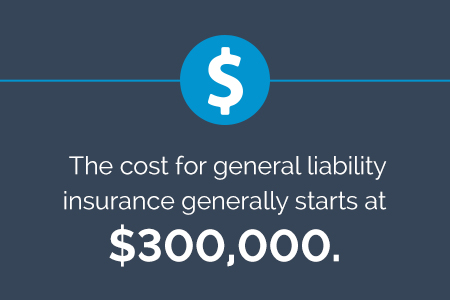
Purchase Necessary Trucking Insurance
For U.S. and Canadian trucking companies, the following forms of insurance are essential:
- General liability insurance — covers most expenses in accidents where one of your drivers is liable.
- Motor truck cargo insurance — covers your business in an event where cargo is lost or damaged.
- Physical damage insurance — covers hospital expenses for drivers injured in roadside accidents while on the job.
- Bobtail insurance — covers accidental expenses that arise when a truck is inactive, including maintenance mishaps.
In the U.S., the cost for general liability insurance generally starts at $300,000 and provides coverage of $1 million per incident and $2 million overall.
Consider Intellectual Property Protection for Brand Trademarks
One last legal area to consider is intellectual property protection. While not generally applicable to the trucking industry, intellectual property can be important if you have a distinct brand logo for your business. After all, you wouldn’t want some rival to copy your logo in an attempt to leach on your company’s reputation.
Step 4: Gather All Your Assets
When you calculate the expenditures involved in the startup of a trucking business, you must first consider the assets that will allow your business to function and achieve profitability. This primarily involves the cost of trucks — whether you buy or rent — and the purchase or lease of an office space and lot.
Additionally, you’ll need to factor in the costs of incorporation fees, licenses and insurance policies.
Calculate Trucking Business Startup Expenditures
How much does it cost to start a trucking company? For the average medium-sized trucking business, startup expenditures generally consist of the following:
- $800,000 — initial fleet of trucks
- $40,000 — office and lot space
- $40,000 — first-quarter payroll
- $5,000 — office furniture and equipment
- $3,500 — phone, Internet, gas and electric deposits
- $2,500 — insurance, permits and licenses
- $2,500 — promotional materials
- $750 — incorporation of business
- $600 — business website
Various additional expenses might arise during the startup of a trucking business, and part of your start-up expense estimates should be analysis of variable and fixed ongoing expenses too. For example, insurance might cost $2,500 as an initial down payment per truck, but since it’s a fixed expense, you can plan accordingly for it as a monthly expense. The best way to find coverage is based on getting several quotes in your area to determine coverage available and a payment plan, and what is covered within liability.
In the case of fuel, which would be a variable expense, if you estimate 120 gallons per truck, and the number of times one truck will fill up in a year, you could spend about $38,000 in fuel, per truck. Factoring this across your entire fleet, 25-40 percent of operating expenses could be dedicated to fuel alone. These are a few examples of specifics you can budget for with a little planning and research.
Procure Financing
To get financing for the startup of your business, you will need to present your business plan in a succinct, compelling manner. Your business plan should include details about how you intend to run your business, promote your brand and generate profit. The purpose here is to convince lenders your business will be a profitable venture and a wise investment.
Startup funds can come from several sources, such as lending banks, business grants and donor funds. Some trucking businesses take out loans for their initial startup, while others are funded by the joint monies of entrepreneurial partners. You can even raise at least some of the capital through the sale of stocks and high-valued assets, such as gold, silver and diamonds.
Step 5: Find Clients/Hauls
When you map out the market for trucking patrons in your area, make a list of applicable industries that reside in reasonable proximity to your eventual base of operations. Is your area ripe with farmers and/or industrialists? Contractors and/or merchants? Those and others could form the bulk of your patronage.
Create a Brand Identity
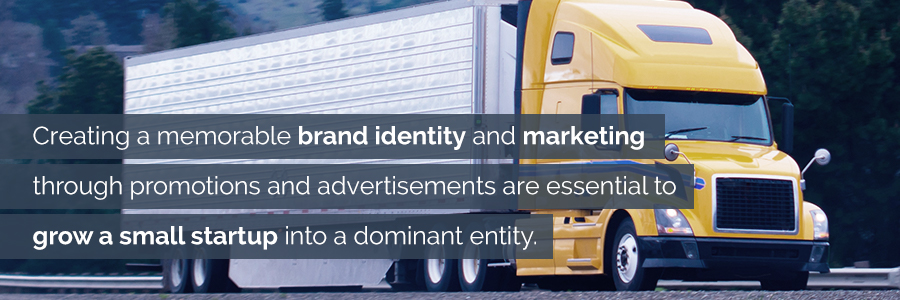
To grow from a small startup to a dominant entity in the trucking industry, you will need to establish a brand identity that sets you apart from the competition. In addition to a memorable company name and distinct, trademarked logo, this will require target marketing through promotions and advertisements.
To make these efforts most effective, speak with a local consulting firm to gain market-tested insights on how to connect with prospective patrons in your target industries.
Promote Your Trucking Business
During your initial launch, distribute an introductory letter and business brochure to the executive departments of companies that use trucking services. From day one, expose potential market segments to your brand with the following materials and promotional media:
- Brand shirts/caps/buttons for all employees to wear on the clock
- Billboards, signs and banners posted in choice locations
- Prominent listings in yellow pages and directories
- Advertisements in industry trade papers
- Outreach through social media
- Website banner ads
Once your business gains traction, you may try advertising your brand on television and radio.
US Compliance Services
Now that you have a more concrete idea about how to start a trucking business, it is time to make your dream a reality. At US Compliance Services, we provide assistance to trucking businesses to ensure that they follow compliance laws and file the required paperwork. Our services allow trucking businesses to operate free of legal doubt.
Contact US Compliance Services to ensure your trucking business meets all applicable compliance requirements.
